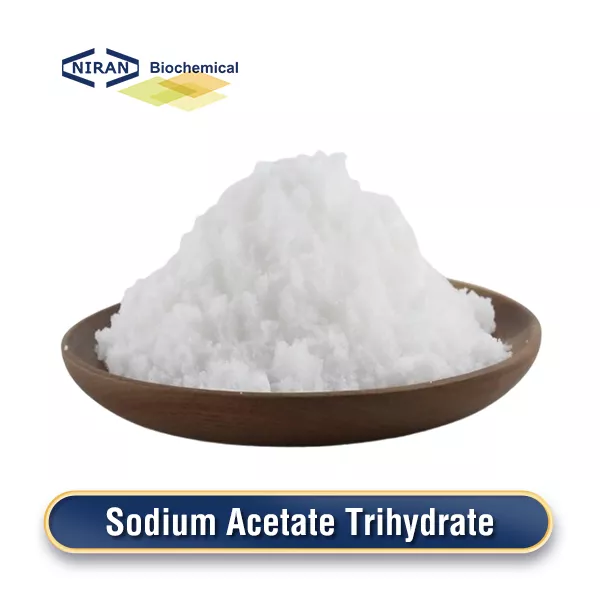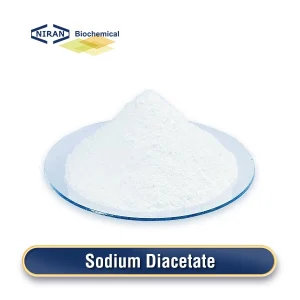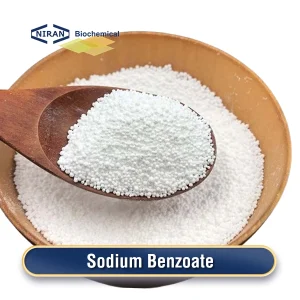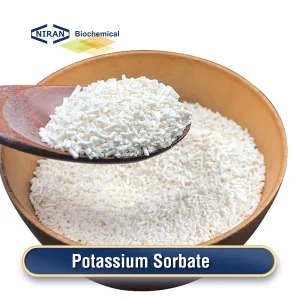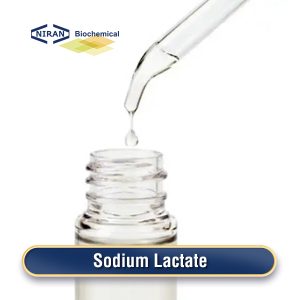Niran Biochemical
YOUR RELIABLE FOOD INGREDIENTS
Send Inquiry
Home » Products » Preservatives » Sodium Acetate Trihydrate
Sodium Acetate Trihydrate
- CAS: 6131-90-4
- Chemical Formula: C2H9NaO5
- Certification: KOSHER, ISO, HALAL, FSSC22000, BRC, etc.
- Standard:
- MOQ: 1000KG
- Shelf Life: 2 Years
Inquire Product
Product Description
What is Sodium Acetate Trihydrate?
Sodium Acetate Trihydrate is an organic compound that forms white or off-white crystals, susceptible to air exposure. It dissolves in water and ether, with slight solubility in ethanol. It finds extensive applications in preservatives, printing and dyeing, medicine, chemical reagents, industrial catalysts, and additives.
Usually, acetic acid and sodium hydroxide are mixed together in a certain molar ratio, and sodium acetate trihydrate is generated through reaction, which can be prepared by crystallization or evaporation of the solution.
Related parameters:
| Items | Standards |
| Content(As Dry Basis), w/% | 99.0-101.0 |
| Acidity and Alkalinity | Pass test |
| Lead (As Pb), mg/kg ≤ | 2 |
| Alkalinity, w/% ≤ | 0.2 |
| Loss on Drying, w/% | 1.0 |
| Potassium Compound | Pass Test |
| Conditions of Transport | Sealed and dry storage |
Recommended dosage
| Food name | Maximum usage(g/kg) |
| Baked Goods | 1.0 g/kg |
| Beverages | 0.5 g/kg |
| Dairy Products | 0.3 g/kg |
| Sauces and Dressings | 0.5 g/kg |
| Processed Meat | 0.5 g/kg |
| Creams and Lotions | 0.5 g/kg |
| Shampoos and Conditioners | 0.2 g/kg |
| Fish and seafood products | 1.0 g/kg |
| Spices and seasonings | 0.5 g/kg |
| Processed fruits and vegetables | 1.0 g/kg |
Sodium Acetate has a wide range of uses
1. Uses in food
(1) Seasoning: Sodium acetate trihydrate is a weakly acidic substance that can increase the sourness of food, adjust the taste and pH value of food, and improve the taste quality.
(2) Preservative: Sodium acetate trihydrate has a good antibacterial effect and can be widely used in a variety of foods, such as pickled meat, pickled seafood, pickles, etc., playing a good preservative role.
(3) Yeast agent for baked foods such as bread: Sodium acetate trihydrate can promote the fermentation process of baked foods such as bread, effectively improving the quality and volume of baked foods.
2. Uses in medicine
(1) Pharmacy: Sodium acetate trihydrate is a commonly used medicament that can be used to treat diseases such as depression, poisoning, and acidosis, as well as for the treatment, diagnosis, and prevention of diseases such as hepatitis and diabetes.
(2) Antibacterial agent: Sodium acetate trihydrate can prevent and control a variety of bacterial infections, such as treating infectious diseases sensitive to antibacterial agents and certain urinary tract infections.
3. Uses in agriculture
(1) Pesticides: Sodium acetate trihydrate can be used to prepare pesticides such as insecticides, fungicides, and herbicides, which have a significant effect on improving the quality of agricultural products and reducing pesticide residues.
(2) Nutrients: Sodium acetate trihydrate can be used as a nutrient in crops and promotes the growth and development of plants.
User asked question:
Q: What is the difference between sodium acetate trihydrate and sodium acetate?
A: 1. Crystal water content: Sodium acetate (anhydrous sodium acetate) has no crystal water, while sodium acetate trihydrate contains three crystal waters. This means that from the chemical composition point of view, the chemical formula of sodium acetate trihydrate is C2H9NaO5, while the chemical formula of sodium acetate is CH3COONa. This difference leads to their different physical forms. Anhydrous sodium acetate appears as a white powder, while sodium acetate trihydrate is a white crystal.
2. Application areas: The two also differ in their application areas. Sodium acetate trihydrate is mainly used in the manufacture of medicines, dyes, photographic agents, sodium diacetate, etc., while sodium acetate is widely used in buffers, mordants, for the determination of lead, copper, nickel, and iron, culture medium preparation, organic synthesis, film printing, etc.
3. Safety and Hazards: The safety description of sodium acetate trihydrate includes S24/25, which indicates that it should avoid contact with skin and eyes during handling, and its hazard description includes R36/37/38, which indicates that it may cause skin allergic reactions and eye damage to some people. This should be noted when using and handling.

